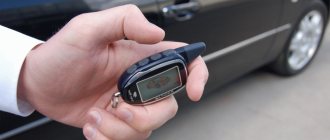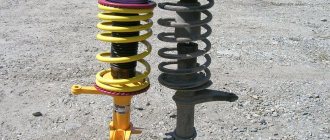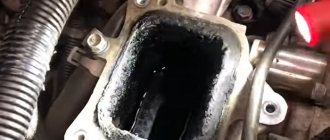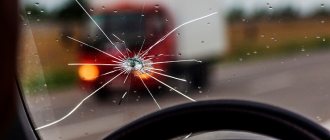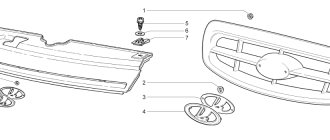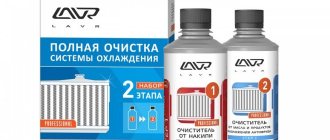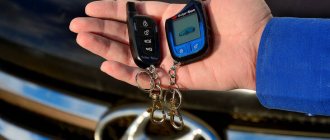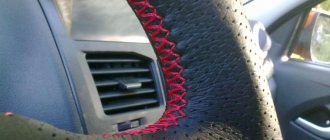The main purpose of a car horn is to warn other road users of potentially unsafe situations.
In principle, a standard horn fully satisfies these requirements, but for some car owners its sound does not seem loud enough.
Many motorists are simply delusional with the idea of uniqueness of their car, and for them the possibility of installing a different sound signal will also not seem superfluous. But what can the modern car market offer them? Let's try to understand this insufficiently covered topic.
Car horn device
The term itself came into use thanks to a company that manufactured such devices at the beginning of the last century (Klaxon Signals Ltd). Today, the word “horn” refers to both a technical device for issuing a sound signal and the signal itself. We will use the term exclusively in the first meaning.
So, according to the method of producing sound, car horns are divided into three large categories:
- electromagnetic;
- pneumatic action;
- electronic.
We will look at the features, advantages and disadvantages of each variety a little later. Although the global and most important characteristic of these devices is the noise level, car audio signals differ both in sound tone and, naturally, in their design. In particular, it is customary to distinguish between tone and sound horns based on their sound, and horn/hornless horns based on their design. There is a clear relationship between these categories: tonal ES have a horn design, while audio ones, as a rule, have a hornless design.
The hornless noise horn consists of a steel body (1) with a membrane and an electromagnet inside. The electromagnet includes a yoke (2), an armature (4), a magnet core (5), and a coil (3). Closer to the outer part of the horn (between the body and the cover (9)) there is a membrane rigidly connected to the electromagnet armature.
Behind the membrane there is a resonator that enhances the level of noise emitted by the horn and also regulates the tone of the sound. The electromagnet is powered through the breaker contact group (7).
The thickness of the membrane also affects the tonality of the sound: the thicker it is, the lower the tonality.
A tone horn horn consists of a body (1), an electromagnet, a membrane (6), a cover (8) and a horn body (7). The electromagnet, as in the first case, includes an armature (3), a core (2) and a yoke (5). Thus, in principle its design is not much different from its noise analogue, but the fundamental difference is the absence of a resonator. Its role is assigned to the air column formed in the horn. The configuration of the horn is such that, due to a change in the vibration frequency of the membrane, the level of the air column also changes. The latter is precisely responsible for obtaining a certain tone of the horn sound. The end of the horn is made in the form of an expanding bell like a horn, which is why it is sometimes called that.
To minimize the sparking inherent in the operation of the chopper, in both types of audio signals additional capacitors or resistors are included in the circuit. In budget devices, the installation of means that reduce sparking is not carried out.
Premium segment
BOSCH 9320335206
This product can be installed on almost any vehicle.
This device has a good clear sound, which makes it possible to signal other road users. It can be used in different climatic conditions, including long trips with climate change. Resistant to high and low temperatures. At the same time, it retains its characteristics. The material used to make the socket is plastic. This model will serve as a driver's assistant.
The device costs 2300 rubles.
BOSCH 9320335206
Advantages:
- Universal design solution “snail”. This design is reliable, versatile, and easy to install, which are its main advantages.
- The device can be used at a voltage of 12V. Power supply from such a network makes it possible to use it in any passenger car or minibus.
- Has a good level of sound power. It will be clearly audible at a distance of 1-2 meters from the car.
- Produces sound using a membrane. Reproduced using an electromagnet.
Flaws:
- not found.
Hella 3FH 007 424-811
The history of the brand goes back 100 years, during which the company produced various accessories for cars of high quality. Products for car signals were among them; operation took place under different conditions. They are used to indicate turns, warn of danger and in other situations. This model is offered to the attention of car owners.
Used in cars with 12V voltage. This device produces a sound of good timbre and volume, the sound propagates over a decent distance. Devices of this type have a plastic case, characterized by compact dimensions, made in red and black colors. The housing is equipped with a Teflon seal for moisture protection. This model can be installed in two positions: vertically and horizontally. This makes using the product comfortable.
Costs 1700 rubles.
Hella 3FH 007 424-811
Advantages:
- good volume and power indicator provide safety to the driver and passengers of the car;
- plastic body;
- sound spreads over a large radius;
- anti-corrosion protection;
- attractive design solution in a sporty style;
- installation horizontally or vertically;
- presence of a moisture-proof Teflon seal.
Flaws:
- not found.
The working principle of a car horn
Like the design diagram of horn and hornless sound signals, their operating principle is largely similar. The main actuator in both cases is an electromagnet. Power is supplied to the coil through the breaker contact group. The sound source is a membrane rigidly connected to the armature of the electromagnet. When you press the signal button, a current is supplied to the magnet, which sets the armature in motion - being attracted to the core, it affects the membrane, which begins to bend.
This is a cyclic process: as the armature moves, the contacts of the breaker begin to open, the membrane, trying to return to its previous position, puts pressure on the armature, which also returns to its normal place. It is the vibrations of the membrane that form the sound, the tonality of which depends on the frequency of the horn.
Cars usually use a parallel circuit for generating low/high pitch signals, which as a result overlap each other quite harmoniously, generating a multi-tone audio signal. As a rule, in absolute value the difference between high/low frequency signals does not exceed 70-100 Hz.
In addition to frequency and sound level, a car signal is characterized by such parameters as spectral composition and sound pressure level (a value measured in decibels). Transport noise is best covered by sound whose frequency spectrum is in the range of 1800-3500 Hz. All parts of a car horn are oriented towards these values, from the membrane to the resonator, as well as their shape, configuration and materials of manufacture.
Electromagnetic horns
It is this type of sound signals for cars that has become most widespread, largely due to the simplicity of the design and attractive cost. As we have already said, the main components of such devices are a pair of diaphragm - solenoid (electromagnet). According to their design, electromagnetic horns are divided into three subcategories:
- a snail that is relatively large in size due to its funnel-shaped geometry. For horns of this type, the maximum beep power level is about 120 dB - this is enough to effectively influence pedestrians and vehicle drivers. Due to its large dimensions, the snail is not easy to mount, and on many modern cars it is completely impossible to find a place for them in the engine compartment;
- The disc horn is the most compact in its class, providing a monophonic sound with a frequency of 350-400 Hz and a power of up to 115 dB. Due to its small size, it can be installed both in the engine compartment and outside (for example, on the radiator grille). There are disk devices of collapsible and non-dismountable designs;
- The horn horn resembles a pioneer horn in appearance, but structurally it is the same snail, but straightened and with a bell. Most often, such a signal is mounted outside the car; when located in the engine compartment, the sound volume is noticeably reduced.
Pneumatic (air) signals. How to make a powerful signal
The principle of operation of such horns is reminiscent of the ancient “horns” that were installed on horse-drawn carriages and the first steam cars. The air moves from the compressor through a special tube, causing it to vibrate and make quite loud sounds. There are many varieties, from 1000 rubles to 30,000 rubles. We have the cheapest ~1200 rubles in the local car market. Today we will upgrade the signals. And so for this you need: The signal itself is like faa faa A cylinder from a used fire extinguisher And an electronic valve. The first point can be dealt with easily, the price of the issue is 1200-1800 rubles in any car market. And with the remaining two it is a little more difficult. And then it dawned on me, what if instead of a storage tank we simply use a second pump. In any case, the pumps are not the most powerful, there will be an increase in power, but not 100% of course, I think it’s worth waiting for a 30% - 40% increase in power. I’ll say right away that there will be no tests with sound recording through a camera or phone! There is also nothing to take measurements with. It will be a purely personal opinion, it is your right to believe or not. In any case, it is not possible to transmit sound volume through the camera. And so let's go. For the upgrade we will need: The signal itself is of the faa faa type. An additional pump. A tee tube to fit into. We already have a signal, all that remains is to buy a pump at the local car market and a tee at a hardware store. I bought an additional pump for 400, and a copper tee for 75 rubles, why copper, but I just came across one that matched the diameter.
Before we begin, a few words about delivery. The parcel arrived in a simple black package. It was not even wrapped in bubble wrap, but in thin foam rubber.
Package
The box was damaged, as was the fastening inside.Broken mount
Looking ahead, I will say: the pipe itself is plastic with a chrome coating, imitation metal. I will even say that all the signals of this form are the same, as if they were produced at the same factory, even if you buy them from China, or in local stores. Everything inside the box is standard: pipe, pump, hose and mounting bolts
So. Everything was purchased for an upgrade. True, the pump turned out to be blue, but it’s okay, they are the same.
And a tee
Let's figure out how to put everything together compactly.
Yes, it is better to coat all the joints in the pipe with sealant before final assembly, since they do not inspire confidence; you can use any automotive sealant, since we use it as glue, so that nothing comes loose due to vibration. In any case, it won’t be worse, since we still want to add an additional pump, and this is an additional load.
not to look nervous
The old signals were installed between the radiator and the grille
We open 4 screws and carefully bend the plastic grille of the bumper, since it cannot be removed separately from the bumper, it is one piece.
There won’t be a video of me driving and scaring passers-by with my signal, I’m not the same age anymore, and junk tinting was banned a long time ago. As a result, what I can say is that it became louder by about 50% percent, purely my subjective opinion. There is definitely no problem that you won’t be heard! It would be possible to measure consumption with one and two pumps. If someone is very interested in this, write in the comments, I will measure it and add it to the review. The price of the product is now too high. Those who want to repeat it can buy it in any store, even a local one. Well, if someone has points or coupons, you can do it via the Internet.
In the summer I want to make a signal like that of trucks, instead of a compressor, these or a car pump. There is a fire extinguisher cylinder, all that remains is to find the electric valve. I think the auto truck shop will have it. That's all. Thank you for reading to the end, happy shopping on the Internet everyone.
The product was provided for writing a review by the store. The review was published in accordance with clause 18 of the Site Rules.
Pneumatic horns
In horns of this type, the generator of sound signals is the same oscillating membrane, but it is driven not by an electromagnet, but by compressed air. The horn is designed to greatly amplify the sound of the signal.
If you want the sound of your car horn to scare away birds at a distance of up to half a meter and don’t know what type of horn to install on your car, feel free to choose a pneumatic one. It provides sound at a level of 145-150 dB.
Such powerful horns can structurally consist of four tubes, and to generate diaphragm oscillations with a frequency of 400-800 Hz, compressors capable of pumping up a pressure of at least 60 atmospheres are used.
The presence of several tubes provides the possibility of multi-tone sound, and even playback of simple melodies. Of course, the dimensions of such a sound device cannot be small, and to reproduce multi-tone sound, microprocessor controllers are used to control the operation of the compressor and other actuators.
Electronic signals
Strictly speaking, horns that operate under the control of an electronic chip are considered a separate type of car horn. But here the electronics are also a sound generator (instead of an oscillating diaphragm), and an electrodynamic loudspeaker plays an important role, amplifying the signal. Its peak power is 110 dB, but the frequency range can vary significantly from model to model.
Electronic horns are the most compact; there are usually no problems with their installation; they can operate on a 12 or 24 V mains voltage and reproduce single-tone sounds or polyphonic sounds, including melodies.
Please note that you should not get too carried away with giving non-standard signals: they are allowed only in cases where this is required to prevent an accident. It is prohibited to sound signals within the coverage area of the corresponding road sign (3.26). The traffic police officer will definitely not like the sound of the horn, which resembles a special signal - in this case, you will probably get into trouble.
Please note that the fine for such violations is standard – 500 rubles.
Fixing a faulty car horn
The most common malfunction is contact oxidation. In some cases, the latter fall out or move away. In situations where the emitter does not work, start your inspection with the condition of the wiring.
Before working with electricity, be sure to remove the terminals from the battery! Disconnect and discharge the capacitor that controls the airbag. Its contacts are most often located under the steering column.
The three contacts are usually located near the hub, protected by plastic. Clean them with a file and firmly fix them in their original position. Here you may need the help of a friend to remove the casing.
Non-standard solutions
For many people, the desire to get an exclusive signal is so great that they are ready to do anything to achieve this goal. In particular, car horns that imitate husky steamships or shrill locomotive horns are becoming increasingly popular. Possessing enormous power, they will definitely attract attention to your car, but you should understand that the attitude towards this will not always be admiring. And such horns require significant space in the engine compartment.
What are the devices used for?
Almost every vehicle has a built-in horn. Cars, motorcycles and even some bicycles are equipped with this device as it helps in preventing many accidents. For example, a driver might honk his horn to let people pass at a crosswalk or to overtake another vehicle.
Unfortunately, in the modern world, sound signals are rarely used, since there is practically no need for them, especially if there are traffic jams on the roads. But some drivers also forget about the rules of the road and use horns only for personal purposes. For example, to honk at a friend or show off your car to the girls.
Features of horn installation
When purchasing a car signal, you will probably find instructions for self-installation in the box, but you should understand that you should undertake such work only if you are sure that you are doing everything correctly. If there is no such confidence, then it is better to entrust the installation of an electric sound signal on a car to a specialist.
If the type of the new horn matches the type of the standard one, there should be no problems: just dismantle the old device and install a new one in its place. If the dimensions do not match, you will have to look for another place and tinker with the fastening. The most difficulties arise when installing pneumatic signal devices. Here, in addition to the horn itself, it will be necessary to install a powerful compressor, the dimensions of which cannot be compact.
In addition, the pneumatic horn compressor will consume a lot of energy, so you should make sure that the parameters of the generator and battery can ensure its operation without damaging the on-board electrical network.
How to connect via relay. Scheme
At home, we will first prepare the mounting of signals from the Volga based on a steel angle purchased at any building materials store. For example, I recently gave a car I had made to a man, and over time his signal stopped working.
I connected the power to the standard signal circuit, there is a 16A fuse there, in addition to the signal from this fuse, the rear brake lights and interior lamps are powered, all of which are LEDs. Well, somehow it’s not solid. Take it and connect!!! Everything turned out perfect. In this case, the contacts close, which again leads to the passage of current through the winding. The wires to the fog lights come from the fuse box, but they go through a relay along the way. The signal worked in such a way that my ears remembered this sound for a long time... That's all. All powerful consumers of electricity in the car, such as headlights, starter, fuel pump, heated rear window, electric power steering, are connected through a relay. With this anchor, the rod that bends the membrane begins to move, and thanks to the nut, the contacts open, which helps interrupt the electrical circuit.
The horn winding is burnt out. Let's look at installing a relay using the example of a gas pump. I connected the power to the standard signal circuit, there is a 16A fuse there, in addition to the signal from this fuse, the rear brake lights and interior lamps are powered, all of which are LEDs. I used the plates that held the old stock signal in place.
Using this circuit, you can connect almost any powerful device and control it with a small, beautiful key. You can adjust the sound of signals from the Volga by rotating the special. Additional signal switching relay We fix the ground wire of the relay, contact 86, under the flange of the relay mounting to the car body through a castle washer to ensure electrical contact, having previously installed a tip with a fastening eye on the wire. For everyone else, the diagram is below.
As a result, numerical values should appear on the display. In order for the signals to fit, you need to file the “pipes” a little on the sandpaper. In some cases, a relay can be a salvation from factory defects. The upper trim on the radiator grille can be installed without any problems. How to install a horn on a VAZ 21102 via a relay
Top 5 Car Horns
Let's look at the top five horns based on the results of an analysis of sales of such devices.
- Hella 3FH 940
This model from a famous German manufacturer of auto parts tops our top of the best sound signals for a car. The device belongs to the middle price category. At a cost of about 850-900 rubles, the 3FH 940 provides a sound pressure level of around 110 dB. The total power consumption of 2 horns is 140 W. The diaphragm oscillation frequency is 415-510 Hz, rated voltage is 24 V.
- PIAA Superior BassHorn HO-9
The Japanese Automotive Parts Corporation offers a model that provides a powerful, sharp two-tone signal in the low frequency region. The cost of the Superior BassHorn HO-9 is quite high - from 3900 rubles, and you get a horn horn operating at a frequency of 330/400 Hz and generating a sound power of 112 dB. Weighing 1 kg. The sound signal operates on 12 volts.
- AVS Electric HR2001
A well-known domestic manufacturer of auto accessories and electronics offers a disc-type horn at a price of 380 rubles - a budget solution that can be installed instead of a standard horn. Provides sound power of 115 dB, with an oscillation frequency of 310/4120 Hz. Operates from a 12 V network and consumes no more than 8 amperes.
- Vympel SA-01
Another budget option costing from 300 rubles (this brand is produced with Russian registration in China). Consists of two high-frequency snails (410/5210 Hz). Provides two-tone sound with a power of 118 dB.
- Mitsuba HOS-04GL
Our rating is completed by a product from another well-known Japanese manufacturer of automotive electronics. The turbine-type sound signal HOS-04GL generates a monophonic sound at a frequency of 400 Hz with a power of 110 dB. This device consumes only 4 A, has a compact size, so it can be installed on any car model. At a cost of 3,000 rubles, the horn cannot be called affordable, but this is the price for real Japanese quality and reliability.
What to pay attention to
Although there are no requirements in GOST (except perhaps a fine for the absence of a signal), it is important to remember that high-frequency beeps are standardized, so make sure that the main frequency remains unchanged. In addition, you should not choose horns that imitate a steam locomotive or other vehicles that a pedestrian or motorist in the oncoming traffic simply does not expect to hear. Think about your health, as doctors do not recommend using signals with a frequency of more than 440 Hz. If you are planning to purchase a powerful multi-voice horn, then do not forget to take care of high-quality sound insulation in the car. In addition, pay attention to the following nuances:
- Before purchasing, you should make sure that the vehicle battery will “pull” the selected horn. If you plan to combine several beeps, the battery will discharge very quickly, since such “toys” are voracious and consume about 20-25 A.
- When choosing a horn, check with the seller whether you will need to connect the horn to power or whether you will need to purchase a compressor (which may be included) for operation.
- If you need more bass in the horn, then choose low-frequency models, and vice versa, for a subtle sound, high frequencies are better suited. For a polyphonic melody, both are used.
- Remember that voltage is different in cars and trucks. For cars it is 12 V, and for trucks it is 24 V.
You can find out how many melodies the horn plays, as well as how many bells it has.
